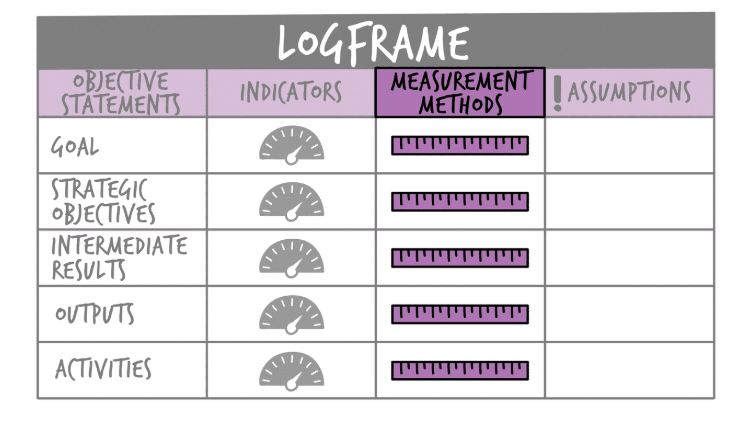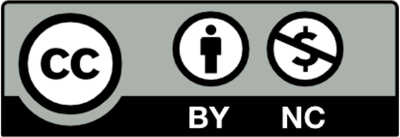Measurement Methods
I want to identify how data will be gathered to measure project progress...
What are they?
Measurement methods identify how data will be gathered to measure project progress. They are an important component of a project logframe.

Measurement methods are divided into two categories: quantitative and qualitative.
- Quantitative methods collect data that can be counted and analyzed statistically to calculate percentages, averages, ranges, variances and more.
Examples of quantitative measurement methods include tracking logs, questionnaires, structured observation, knowledge and achievement tests and physiological health status measures. These methods are especially good at collecting data that tells you what is happening with the project, answering questions such as “how many,” “how much” and “how often.” They also help identify who the project is interacting with and supporting.
- Qualitative methods capture participants’ experiences using words, pictures and stories and help track changes in participants’ attitudes and perceptions.
Examples of qualitative methods include case studies, interviews and focus groups.Qualitative measurement methods are especially good at answering the questions, “How is change happening?” and “Why is change happening?”
MEAL experts have determined that all good indicators should be SMART: Specific, Measurable, Achievable, Relevant, and Time-bound.
How do I use them?
When choosing measurement methods, first review the project indicators. Certain measurement methods will be more suited to specific indicators than others. And, some indicators may require two measurement methods to help you track them completely.
As a best practice, projects are encouraged to include a mix of measurement methods (both quantitative and qualitative). A mixed-method approach to collecting data is useful because both quantitative and qualitative methods have weaknesses that can be minimized by the use of the other.
For example, while quantitative data is very useful for collecting standard data from a large number of people, it may not tell you much about the depth or complexity of an issue. Combining this quantitative data with qualitative data will give teams a much richer understanding of the changes the data identify.
And, a mixed methods approach can strengthen your data analysis and interpretation if you consciously plan to incorporate a process called triangulation.
- Triangulation involves the validation of data through cross verification from more than two sources.
In other words, teams triangulate by collecting data using a mix of methods. This allows them to cross-check and reinforce results. And, triangulation helps overcome some of the weaknesses of the methods outlined above.
When do I use them?
Decisions about which measurement methods the project will use are made during the design phase of the project – when the logframe is being developed.
During project implementation, the project team develops the data collection tools that correspond to each measurement method. Remember to plan time to design and test your data collection tools. See these MEAL DPro Starter pages for more on the design and use of quantitative and qualitative tools.
Once designed, the data collection tools that correspond to your measurement methods are used throughout the project implementation time period. The frequency with which tools are used depends on their purpose. A quantitative checklist used for monitoring purposes will be used more often than a series of focus groups designed as part of an evaluation.
Tips:
TIP 1: Primary or Secondary Data?
When identifying measurement methods, it is useful to consider whether you need primary data to measure your indicator, or whether you can rely on secondary data.
- Primary data sources require that the project team and stakeholders directly collect the information needed to measure progress against an indicator. Generally, primary data sources provide the most reliable and appropriate data for measuring the progress of your project.
However, when possible you can consider using using secondary data sources.
- Secondary data sources rely on information that is already available through other sources (published or unpublished). The advantage of secondary data is that they are cost effective and reduce the risk of duplicating effort. Examples of secondary methods include existing records, statistics and reports.
In practice, access to secondary data is often limited. It can be challenging to find data that directly address the precise data needs of your project. If you choose to use secondary data, be clear about the criteria you use to confirm that the data are valid, reliable and directly represent your area of interest.
TIP 2: Have you involved project stakeholders?
When selecting measurement methods, consider which methods will be most appropriate for use with your stakeholders. Are your stakeholders literate? Do they have connectivity? Are there times of the year that are more convenient for data gathering than others? The answers to questions like these will inform which measurement methods are most suited for the project.
Also, it is useful to consider whether the methods chosen can be designed to involve stakeholders in the data collection process. This is a recommended practice as it helps improve transparency and commitment to MEAL efforts.
TIP 3: Are there resource constraints?
Finally, decisions about the measurement methods you select will also be influenced by the resources available. Data collection is costly. Teams must have the resources (time, staff, and money) to implement the chosen mix of collection methods.
Supported by:
Shared by:
Users are free to copy/redistribute and adapt/transform
for non-commercial purposes.
© 2022 All rights reserved.




